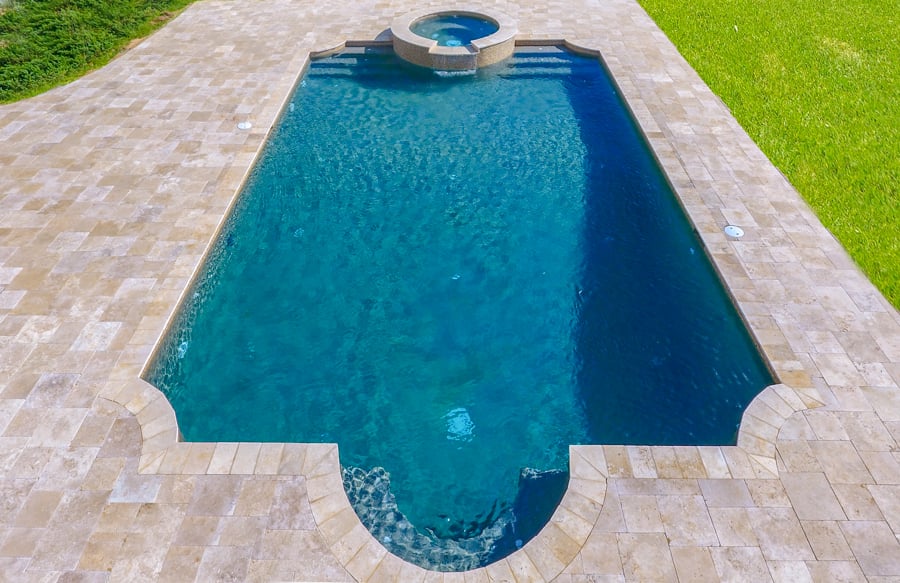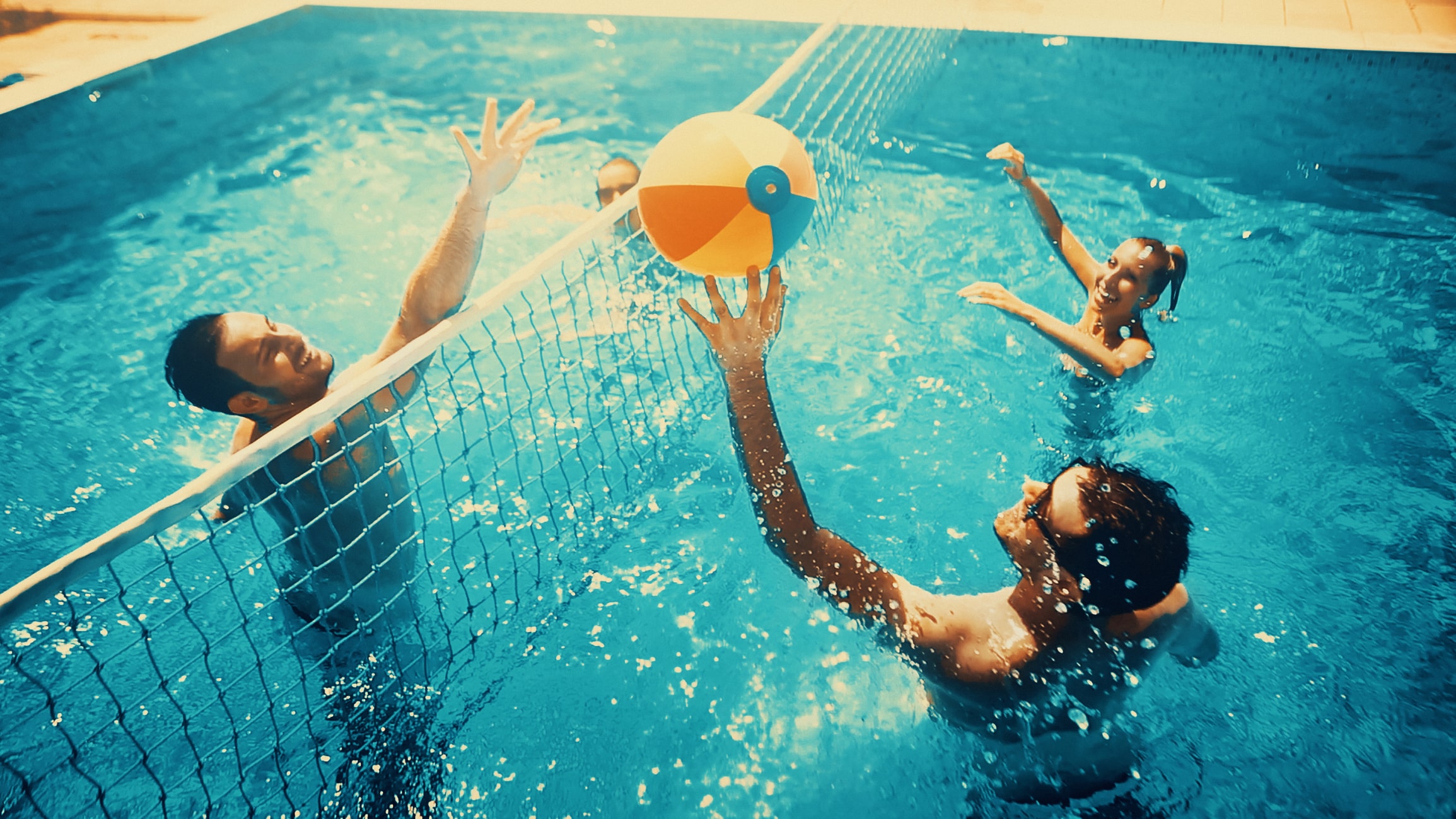—Gain functionality and save on operating costs by reducing your pool’s depth

Have you ever thought about changing the depth of your swimming pool?
If you have a deep backyard pool and are planning its renovation, consider the advantages that come from making the deep end shallower.
For many homeowners, a swimming pool with a deep end is less than ideal. While a 7- or 8-foot depth was common among backyard pools built years ago, the trend today is a pool that foregoes the deep end.
In fact, most new residential pools are being built with a deepest area that ranges only 4-1/2 to 5-1/2 feet. This increasingly popular design is called a play pool or sports pool.
Typically, play pools are 3 feet deep at the stairs, 5 feet deep in the center, and 3 to 4 feet deep at the other end. Sports pools have the same general depth profile, but they tend to be symmetrical in shape; that way, you can easily divide the pool into equal halves for team water sports.
In many cases, a pool remodel specialist can cut the water depth by several feet. Depending on a pool’s existing dimensions, it may even be possible to create an approximate configuration of a play or sports pool.
By doing so, you will have an aquatic retreat that’s more economical and far more functional. Let’s look at the reasons why. 
Expert Tip: For safety reasons, do not modify the depth of a pool with a diving board or platform or large slide that creates high-velocity water entries. These accessories require greater water depths. Learn more about swimming pool dimensions, and ask your remodel specialist what’s appropriate for your pool.
Swimming pool remodels: Why going shallow—and losing water—adds value
Yes, changing a pool depth to make it less deep causes loss of water volume—and that’s a good thing!
First, let’s break down what changes in your pool when you make its deepest area shallow. By reducing the depth, you decrease the overall volume of water the pool holds.
Let’s say a freeform pool measures 15 x 30 feet with a depth range of 3 to 8 feet. That means it has a total area of approximately 380 square feet, and it holds about 15,000 gallons of water.
However, if you reduce the depth to a maximum of 5 feet, that same pool will contain about 11,400 gallons of water—only three-quarters as much as before.
This volume loss will generate a gain: Less pool water means lower expenses. That’s right: A shallower pool saves money by cutting operational costs in several ways.
How a shallower pool boosts efficiencies
The first way a shallower pool saves is on chemical purchases. With a smaller volume of water to treat, less sanitizer, algaecide, oxidizer, and balancing agent is needed to maintain a healthy swimming environment.
So, if your pool relies on old-school chlorine—versus an advanced sanitizing system like ozone, ultraviolet light, or advanced oxidation process—you will be able to cut back on your tablet, liquid, or powder purchases.
Less water volume also cuts the length of time your filter and pump must operate. For example, the 15,000-gallon pool described above will typically require your single-speed pump to run 6 to 8 hours each day to adequately filter the water.
On the other hand, a deep-end pool that’s been reduced to 11,400 gallons will have lost 25% of its water volume. So now, the same pump and filter will need to run for only about 4 to 5 hours daily to treat the entire pool. That shorter daily run time matters: Less operating time means lower energy bills.
Another way a shallower pool lowers expenses is in heating. A smaller volume of water requires less energy to heat it. Since the water temperature will rise more quickly, you may be able to install a new heater with a lower BTU rating. Or, it may allow you to use a unit with the same rating, but to run it for less time.
Even if you have a solar pool heater, you will also enjoy a benefit. Water volume affects the rate at which water temperature rises or falls when solar conditions change. That means after a cold spell, your shallow pool’s heat will recover in far less time (often a matter of days).
Yet another benefit is how pool “housekeeping” will be more convenient. Ever have to fish a piece of debris, some loose change, or a toy out of the bottom of a pool’s 8-foot deep end? Well, removing the same objects from a 5-foot depth is a much easier task. You may not even need to extend the pole on your pool net.
Your automatic pool cleaner will have it easier too. Since even the best models face an extra challenge climbing in and out of a 7- or 8-foot deep end, the cleaner can operate more efficiently without getting caught or slowed down in the deep end.
Increased pool usability and having more fun
The other major advantage to a shallower pool depth is an aquatic playground with much more usable space for everyone’s enjoyment.
Here’s why: Even an NBA player can’t keep his head above water that’s eight feet deep. So how can the average person—let alone a child—be expected to do so?
To give everyone—particularly your little ones—more space to play in the pool and engage in water games, you need an area that’s less than 4 or 5 feet deep. The best pools to play in have plenty of space where swimmers can comfortably touch the bottom while keeping their heads above water.

Better Games: Have you ever tried playing volleyball in a deep-end pool? One team will be playing volleyball, but the one on the deep side will be forced into a virtual game of water polo. It won’t be a fair match!
This is why most modern pools are designed as play or sports pools. These designs feature depth configurations ideal for families with kids, average-height adults, and swimmers who like to splash around in the water—without having to tread water in the deep end.
For the reasons previously explained, the typical configuration for these pools call for two shallow ends—each 3 to 3-1/2 feet—with a 5-foot-deep middle, although these dimensions can vary by 6 to 12 inches.
With this kind of layout, some experts believe the pool is slightly safer for children—although adult supervision is always critical.
Shorter dimensions provide a generously sized shallow area for most everyone—except very young children. With a volleyball net strung across the pool center, both teams have equal footing for play. If desired, you will also have plenty of aquatic real estate to add a basketball hoop that everyone can enjoy.
Major pool remodels: maximize your investment
Just as with a major renovation of a kitchen or bathroom, a pool makeover requires a significant upfront investment. But this project will pay off with years of greater ease, sun-splashed fun, and energy savings.
Your pool remodel expert can advise you about the feasibility and cost of removing the deep end on your existing pool. For many homeowners, raising it by several feet delivers ongoing value that makes the initial price tag well worth it.




.jpg?width=1490&name=rock-waterfall-slide-pool%20(1).jpg)